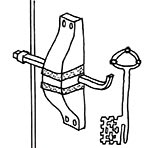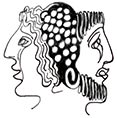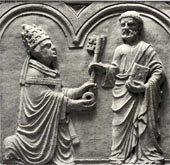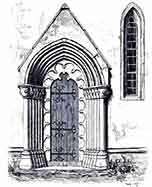Woodeb block locks were among the first door locks that were used on churches. The locks were made of forged components fitted into a rectangular lock body of wood. In the earliest and simplest wooden block locks, a spring-loaded iron bolt was moved to the open or closed position using the key. In the 17th century, many of these locks were replaced with iron tumbler locks.
 |
| Medieval wooden block locks with church keys. Illustration by the author. |
The door – a guarded border
Usually gates and doors do not just symbolize the entrance, but also the hidden room within and the mysterious power that reigns there. A door or gate is a border; you open it, close it, knock on it, bolt it, or lock it. The door is the part of a building that is steeped in most significance. In ancient cultures, gates, doors, and doorways were guarded by lions, dragons, bulls, dogs, or fantasy animals. Both the gates to the house of the ancient Egyptian god Osiris were guarded by two goddesses, and they only let in people who knew the goddesses’ names.
In Babylonia in 600 BC, the country’s main god Marduk was thought to be responsible for the key to the gate to heaven.
The Roman god, Janus, had two faces and was a symbol of entrance and exit. He guarded all gates, doors, and doorways in ancient Rome. He carried the keys that had the power to unlock and lock. All entryways were dedicated to him in the belief that the entry into any action could be compared to going through a door. As a protector of the entrances to buildings, Janus was depicted with a gatekeeper’s staff and a key. He also had the power to close the old year and open the new.
 |
| Head of Janus according to Svenskt Tenn, 1920s. Illustration by the author. |
Samson, the judge, whose immense strength was due to his hair, outwitted those who lay in wait to kill him at Gaza’s gate. He pulled up the doors, posts, and bar of the city gate and carried them to the hill near Hebron (Judges, 16:1).
 |
| Pope Urban VI (1378–1389) receives the keys to his position of office from St. Peter. Photo by the author. |
In the same way that the gates of ancient Rome were guarded by the god Janus, St. Peter is depicted as watching over the gates of heaven with one or two keys. They symbolize the forgiveness of sins by unlocking the door to heaven.
The narrow entrance also symbolizes the eye of a needle (Mathew 19:24), and entering becomes a rite of passage. The entrance led to the “heavenly Jerusalem” and, as Jesus preached, “I am the gate; whoever enters through me will be saved.” The three doors of a cathedral or church still symbolize faith, hope, and charity today.
 |
| The door to Halla Church on the Swedish island of Gotland. Xylography by Wilhelm Meyer, Kyrkliga konsten (Ecclesiastical Art) 1907 |